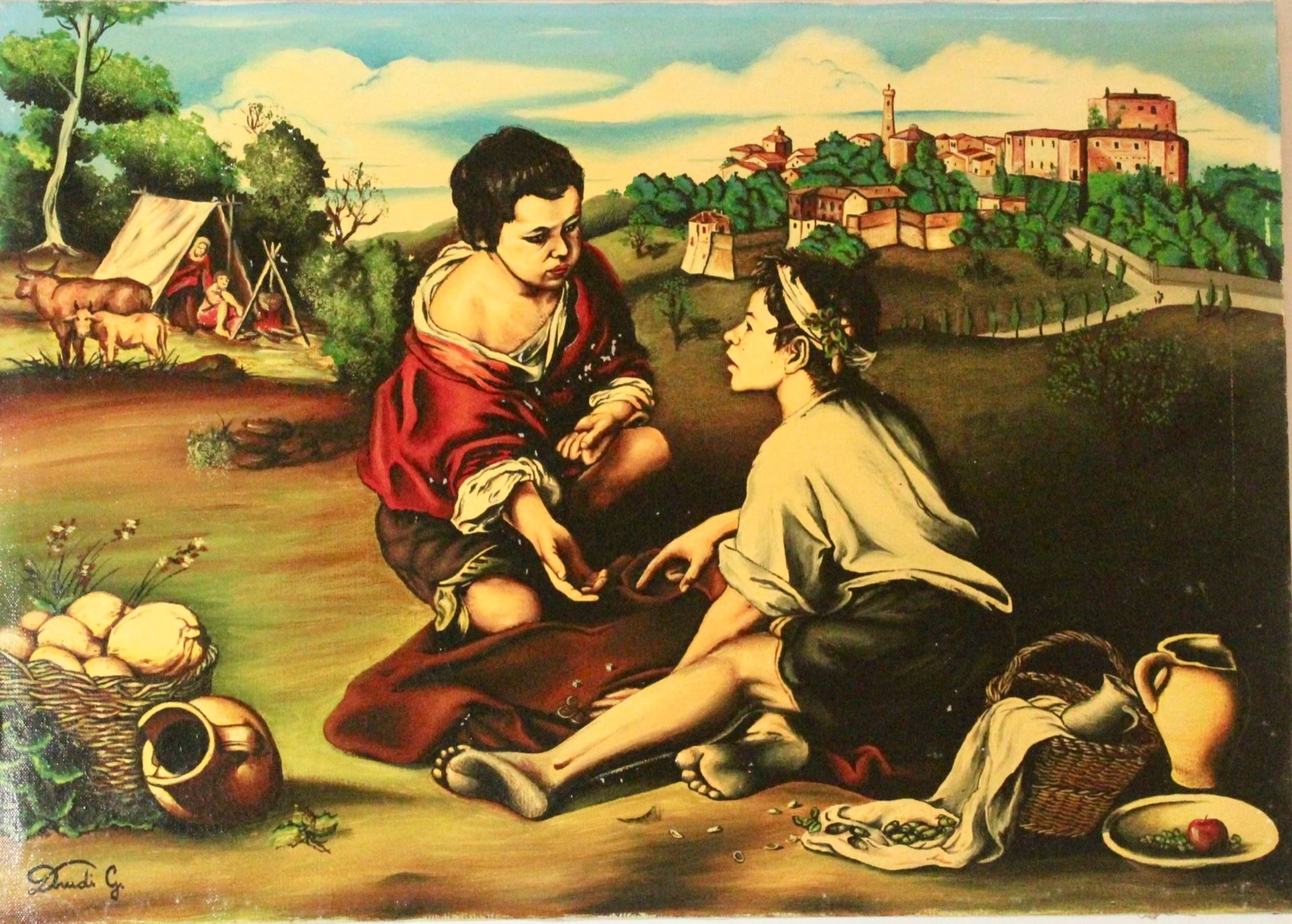THE GYPSIES
1978, 50x70cm, Glossy oil on canvas

The gypsies have camped near the town of Santarcangelo di Romagna. The boys play dice, the mother and daughter prepare lunch by the tent. A bucolic image from another time.
This pictorial work from 1978 represents a scene of daily life of a group of gypsies camped in the countryside near Santarcangelo di Romagna, in a timeless era, suspended between realism and idealization of nomadic life. The painting, with its strong narrative impact, conveys a sense of intimacy and naturalness, evoking the charm of a wandering culture tied to traditions and freedom.
Detailed description of the scene:
The boys playing dice
At the center of the composition, two young gypsies are absorbed in a game of dice. One of them, with a white garment and a crown of leaves on his head, observes with an attentive expression his companion, who wears a red cloak draped over his shoulder. The atmosphere between the two boys is dense with complicity and concentration, emphasizing the moment of recreation and interaction typical of their daily reality.
The nomadic camp in the background:
Further away, the encampment can be seen, with a modest tent and two female figures: an adult woman, probably the mother, intent on cooking, and a girl watching her. Next to the tent, some animals – including an ox and piglets – suggest a self-sufficient life, based on essential resources and contact with nature.
The setting and landscape:
In the background stands the village of Santarcangelo di Romagna, with its medieval towers and houses overlooking the hills, creating a contrast between the stability of the town and the nomadism of the gypsies. The winding road leading to the village seems to want to connect two distinct worlds, that of travelers and that of settled citizens.
The symbolic and bucolic details:
In the foreground, next to the boys, there are two wicker baskets with bread, fruit, and an amphora, as well as a plate with a single tomato, a symbol of the simplicity of their diet. The bare feet of the young people and the direct contact with the earth reinforce the image of an authentic existence, linked to natural elements and freedom of movement.
Interpretation and meaning:
The painting celebrates nomadic life with a romantic and nostalgic eye, returning an image of community and harmony with nature. The choice to portray the young people in play and the women in meal preparation highlights the strong bond between generations, in a culture where family and sharing are fundamental. The work, through the richness of details and the warm color palette, invites the observer to immerse themselves in a distant time, made of simple but significant gestures, in which the relationship between man and environment is still pure and uncontaminated.

The gypsies have camped near the town of Santarcangelo di Romagna. The boys play dice, the mother and daughter prepare lunch by the tent. A bucolic image from another time.
This pictorial work from 1978 represents a scene of daily life of a group of gypsies camped in the countryside near Santarcangelo di Romagna, in a timeless era, suspended between realism and idealization of nomadic life. The painting, with its strong narrative impact, conveys a sense of intimacy and naturalness, evoking the charm of a wandering culture tied to traditions and freedom.
Detailed description of the scene:
The boys playing dice
At the center of the composition, two young gypsies are absorbed in a game of dice. One of them, with a white garment and a crown of leaves on his head, observes with an attentive expression his companion, who wears a red cloak draped over his shoulder. The atmosphere between the two boys is dense with complicity and concentration, emphasizing the moment of recreation and interaction typical of their daily reality.
The nomadic camp in the background:
Further away, the encampment can be seen, with a modest tent and two female figures: an adult woman, probably the mother, intent on cooking, and a girl watching her. Next to the tent, some animals – including an ox and piglets – suggest a self-sufficient life, based on essential resources and contact with nature.
The setting and landscape:
In the background stands the village of Santarcangelo di Romagna, with its medieval towers and houses overlooking the hills, creating a contrast between the stability of the town and the nomadism of the gypsies. The winding road leading to the village seems to want to connect two distinct worlds, that of travelers and that of settled citizens.
The symbolic and bucolic details:
In the foreground, next to the boys, there are two wicker baskets with bread, fruit, and an amphora, as well as a plate with a single tomato, a symbol of the simplicity of their diet. The bare feet of the young people and the direct contact with the earth reinforce the image of an authentic existence, linked to natural elements and freedom of movement.
Interpretation and meaning:
The painting celebrates nomadic life with a romantic and nostalgic eye, returning an image of community and harmony with nature. The choice to portray the young people in play and the women in meal preparation highlights the strong bond between generations, in a culture where family and sharing are fundamental. The work, through the richness of details and the warm color palette, invites the observer to immerse themselves in a distant time, made of simple but significant gestures, in which the relationship between man and environment is still pure and uncontaminated.